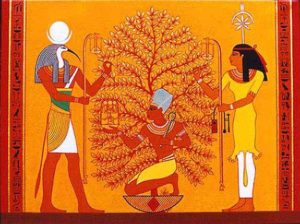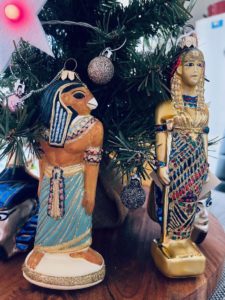
© 2021 Scott Rose
While not an authentic ancient Egyptian custom obviously, last year I honoured my own vision and set up a Kemetic Christmas tree.
The little tree was an experiment, just to see what it would look like, how it would feel, and what the reaction of the netjeru would be. I was really happy with the results. The netjeru, who have an unlimited capacity for graciousness it seems, were quite appreciative of my efforts, same as they are with any offering made with sincerity.
Most of us are already familiar with the importance and significance of animal cults all over ancient Egypt. Tree cults should also be taken into consideration (see the 1947 article, The Goddess of the Egyptian Tree Cult by Marie-Louise Buhl). Several trees were sacred to the ancient Egyptians, including the sycamore (nh.t), date palm (bnr), the broad-leafed persea (isd) and acacia (snd) as forms or attributes of deities. These sacred trees are parallel with the universal Tree of Life (see the 2014 article, The Tree of Life in Ancient Egypt and the Book of Proverbs by William R. Osborne).

Image via Sivana East
According to Matt Caron at Sivana East:
To the Ancient Egyptians, the Tree of Life represented the hierarchical chain of events that brought everything into existence. The spheres of the Tree of Life demonstrate the order, process, and method of creation. In Egyptian mythology, the first couple (earth and sky). They were said to have emerged from the acacia tree of Iusaaset, which the Egyptians considered the tree of life, referring to it as the “tree in which life and death are enclosed.”
Although pine trees do not appear to have been cultivated in ancient Egypt, the Egyptians were no strangers to products such as pitch and pine nuts which they acquired through trade, a fact I discussed last year in part 1. While the ancient Egyptians did not have Christmas trees as we know them today, of course, the concept may not have been too far of a stretch for them, as their culture is known to have prized evergreens. History.com reports:
“At the solstice, when Ra began to recover from his illness [i.e. winter], the Egyptians filled their homes with green palm rushes, which symbolized for them the triumph of life over death. To mark the occasion, they decorated their homes and temples with evergreen boughs.”
The idea of creating a Kemetic Christmas tree was a topic I was hesitant to blog about last year, because no one else was doing it but then, that’s exactly why I had to!
I was worried about making a mistake, or that I would cause offense to the gods and I was also afraid of harsh judgement from other Kemetics. This year, I’m much more confident. I’m glad I listened to my intuition — that feeling of a gentle nudge that won’t go away (and incidentally, has never led me astray). There was something they wanted to show me, a story to be told, a connection to be made. I’m so grateful I listened, and stepped forward with my own ideas, and developed my own eclectic response to a personal relationship with the netjeru. Below is my Kemetic Christmas tree today, one year on. Not too long of course, I realise, but I also know this is the start of something lifelong.
I believe all trees are sacred; each is an embodiment of the great tree of life. Just as we humans are embodiments of the divine.

© 2021 Scott Rose
I’ve acquired some new ornaments since last year, which appear to be leaning toward a) simply acknowledging and celebrating ancient Egypt as a Kemetic and b) the theme of Isis, the resurrection of Osiris, and the birth of their son, Horus. There were some powerful mystical revelations that were given to me regarding these themes, while I was touching the ornaments and decorating the tree. I wasn’t thinking of anything at all when a ginormous connection was suddenly made, sparked by simply touching these objects and allowing my mind to drift. This information deserves its own post without digressing too much from the current topic, so if interested, please look for a link in the comment section below, in the near future.
If we turn our attention back to the Kemetic Christmas tree, this is what simply feels right to me in my own pagan practice. It may not be right for you! In fact, it may seem completely idiotic to you and if so, it’s totes fine. I honour that. Do what you feel guided to do. If my work is about anything, it’s this: follow your intuition. Do what feels right to you on this path, because from where I stand, that’s all we really have. Yes, we’ve got the historical record left behind by the ancient Egyptians. As astounding as that record is, it’s incomplete and often open to interpretation. We may never know exactly what the holidays and customs were like in ancient Egypt, but we know what our holidays are like today, so why not adapt them? In doing so, we are taking a holiday that we grew up with in the 20th and 21st centuries and we’re thrusting it forward in its evolution, which has really been happening the whole time. It’s widely known that the Christmas traditions we have today are pagan in origin, infused with themes from Christianity, and only developed into its modern form in the Victorian era. Christmas is a holiday that’s been evolving for hundreds, even thousands of years. Like I said last year, why throw the baby out with the bathwater?
A Kemetic Christmas tree is more than a sentimental decoration in your home.
The tree becomes a sacred object and does what any sacred object does. It performs a ritual function. That is, it transfers and transmits vital life force energy to and from the netjeru, who are living, non-physical identities or personifications of the creative forces of the cosmos, as seen through the lens of the ancient Egyptians (and modern Kemetics alike).
The vital energy is shared; it does not drain or exhaust you to send out. The energy comes back to you. We are all conductors of life force. This is the reciprocal relationship that exists between us and the divine. Of course, there is no separation between us! The vital life force, or sacred life force, is nurturing, stabilising, uplifting, and amplifying. It’s also self-regulating, self-adjusting and self-balanced. It is living Ma’at and sustenance for all. This is what a Kemetic Christmas tree is really about, what it acknowledges and what it activates: the tree of life itself. The Kemetic Christmas tree is a revival of sorts, of the ancient Egyptian tree cult.
There’s more, there’s always more, but I think that’s enough for now. Thank you, for reading Kemetic Blog. I hope you have a happy holiday season, in whatever way you wish to celebrate your holidays. Stay safe and well. Senebty!
𓆸
© Scott Rose / Kemetic Blog – All Rights Reserved.

1 Comment
Christian and Kemetic Nativity Scenes are One Scene
December 22, 2021 at 4:45 am[…] my last post, I discussed setting up a Kemetic-themed Christmas tree for the second year running and how I […]